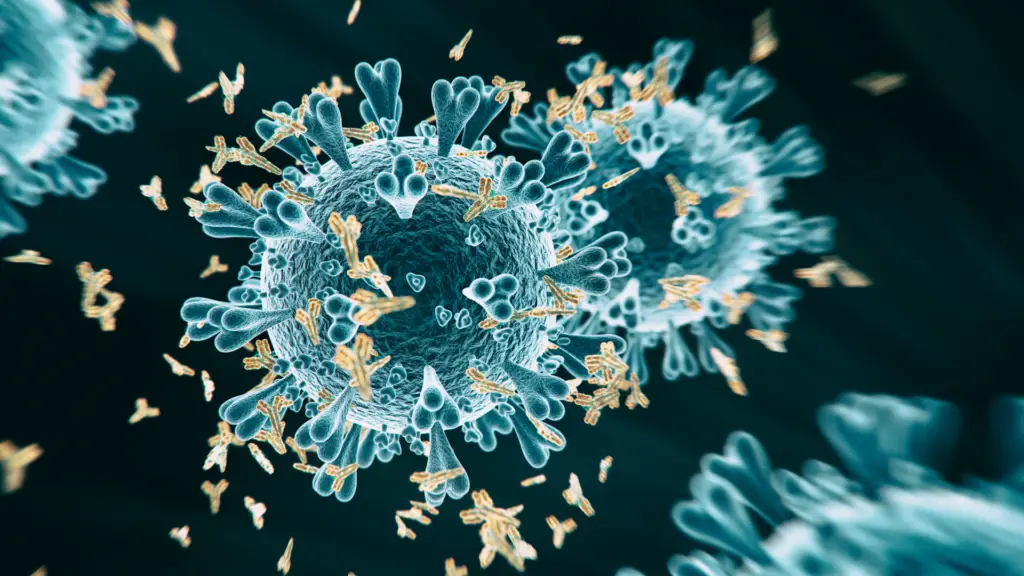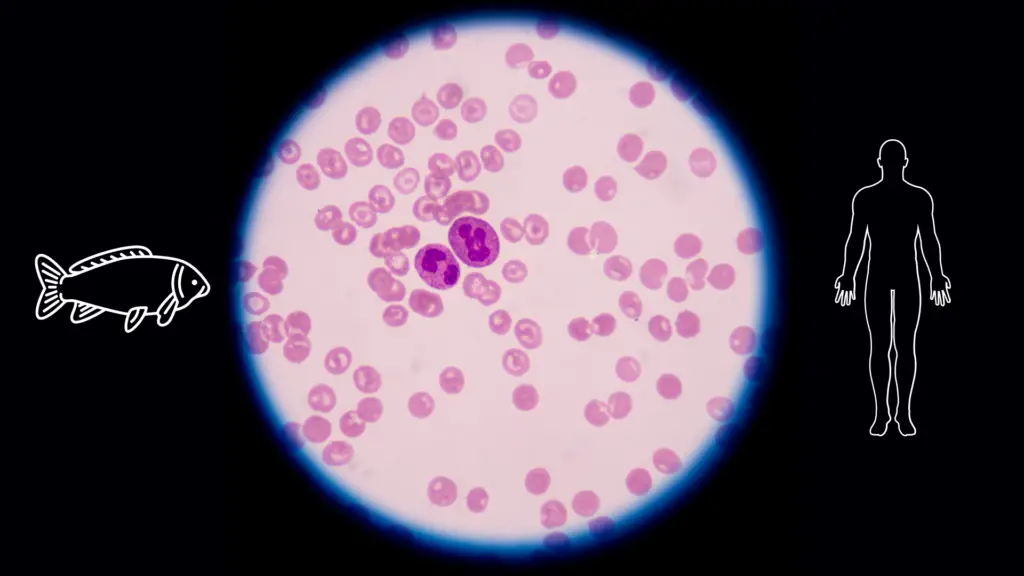The immune systems of both fish and humans share some common elements, such as innate and adaptive immunity, physical barriers, and cellular defenses. However, each system has unique adaptations to suit the specific challenges posed by our environments and hmm… lifestyles. 🙂 In this article, I will provide an overview of the fish and human immunology.
Overview of immune systems
The immune system in vertebrates (so all animals havin a spinal cord) is a complex and sophisticated defense mechanism that protects the body from harmful pathogens, ensuring overall health and survival. This defense system comprises two major components: innate immunity and adaptive immunity.
Innate Immunity
The innate immune response is the first line of defense that provides immediate but nonspecific protection against pathogens and foreign invaders
It includes physical barriers, like skin and mucous layers, which act as protective shields, preventing the entry of microorganisms into the body.
These barriers are supported by cellular defenses, which involve various specialized cells like macrophages and neutrophils.
Macrophages are phagocytes that engulf and neutralize foreign particles, while neutrophils act as first responders to infections, phagocytizing bacteria and promoting inflammation to contain the spread of pathogens. Neutrophils can also release enzymes to kill pathogens externally.
Humoral defenses are another crucial aspect of innate immunity. They consist of the complement system and antimicrobial peptides.
The complement system comprises a group of proteins that can recognize and destroy invading microbes.
Antimicrobial peptides, on the other hand, are small protein with direct antimicrobial effects that aid in the elimination of pathogens.
Adaptive Immunity
Adaptive immunity is a more specialized and targeted defense mechanism that develops over time. It involves the activation of specific immune responses against particular pathogens. This process is orchestrated by B cells and T cells, two key players in the adaptive immune system.
B cells are responsible for producing antibodies, which are Y-shaped proteins capable of recognizing and binding to specific antigens found on pathogens.
Antibodies mark the pathogens for destruction by other immune cells, effectively neutralizing the threat.
T cells play a central role in cell-mediated immunity. They are responsible for recognizing infected or abnormal cells and eliminating them to prevent the spread of pathogens within the body.
Helper T cells coordinate the immune response, while cytotoxic T cells directly attack and destroy infected or abnormal cells.

Immunological Memory
One of the most greatest features of the vertebrate immune system is its ability to develop immunological memory. Upon exposure to a specific pathogen, memory B and T cells are formed.
If the same pathogen is encountered again in the future, the immune system can mount a faster and more robust response, effectively eliminating the threat before it causes significant harm.
Similarities between Fish and Human Immune Systems:
While fish and humans are vastly different organisms, they indeed share some similarities in their immune systems.
Innate Immunity:
Physical Barriers
Both fish and humans rely on physical barriers to fend off invading pathogens. Fish have a skin and a mucus layer covering their body surfaces, while humans have the skin and mucous membranes lining their respiratory, digestive, and urogenital tracts. These protective barriers act as the first line of defense, preventing pathogens from entering the body.
Phagocytes and Other Cellular Defenses
Phagocytes are essential cellular defenders present in both fish and humans. Macrophages and neutrophils in humans, as well as their equivalents in fish, can engulf and destroy harmful microorganisms. These cells play a crucial role in early immune responses.
Complement System
Another shared feature is the complement system, a group of proteins that enhance the ability of antibodies and phagocytic cells to eliminate pathogens. The complement system functions in both fish and human innate immunity, helping to neutralize and eliminate foreign invaders.
Adaptive Immunity:
B Cells and Antibodies
Both fish and humans possess B cells, which are responsible for producing antibodies. These antibodies are essential for recognizing and binding to specific antigens on pathogens, marking them for destruction by other immune cells. This process is critical for eliminating infections.
T Cells and Cell-Mediated Immunity
T cells, found in both fish and humans, play a central role in cell-mediated immunity. They can recognize and eliminate infected cells, stopping the spread of pathogens within the body. Helper T cells coordinate the immune response, while cytotoxic T cells directly attack and destroy infected or abnormal cells.
Immunological Memory
The fascinating aspect of immunological memory is shared by both fish and humans. Upon exposure to a specific pathogen, both organisms can develop memory B and T cells. These memory cells enable a faster and more robust response upon subsequent encounters with the same pathogen, conferring long-term protection.
Differences between Fish and Human Immune Systems
There are of course also differences between the immune systems of fish and humans. These distinctions reflect the diverse evolutionary paths that have shaped their defense mechanisms.
Anatomical and Structural Differences:
Skin and Mucous Membranes
While both fish and humans have protective barriers, the composition of their skin and mucous membranes differs. Fish possess a more permeable skin, allowing for osmoregulation, which can also make them more susceptible to certain pathogens, especially if the mucous layer is removed. In contrast, the human skin acts as a formidable barrier, providing robust protection against invading microorganisms.
Lymphoid Organs and Tissues
The organization of lymphoid organs and tissues varies between fish and humans. Humans have well-defined lymph nodes, spleen, and thymus, which play key roles in immune responses.
In fish the primary lymphoid organs are also thymus (also until maturation), kidney (head kidney) and spleen. Spleen here plays a big role as it serves as a blood filtration organ, since fish lack lymph nodes like e.g humans have. Also other organs, like gills, trunk kidney and even heart can play a role in fish immunity.
Receptor Diversity and Specificity:
Immunoglobulin Genes in Fish and Humans
Immunoglobulins, also known as antibodies, are essential for recognizing and neutralizing pathogens. Fish and humans use different types of immunoglobulins, reflecting their distinct evolutionary histories. Fish have IgM and IgT antibodies, whereas humans rely predominantly on IgG, IgA, and IgE.
Major Histocompatibility Complex (MHC) Diversity
MHC molecules play a role in presenting antigens (the “invaders”) to T cells, enabling the adaptive immune response. Fish and humans have different MHC gene families, leading to differences in antigen presentation and immune recognition.
Cytokine Profiles and Signaling
Cytokines are signaling molecules that coordinate immune responses.
Variation in Cytokine Response
Fish and humans produce different cytokines, resulting in variations in the way their immune systems respond to infections and inflammation.
The signaling pathways involved in cytokine responses can also differ between fish and humans. These differences influence the regulation and coordination of immune processes.
There are, however, numerous cytokines that are structurally similar and/ or play similar roles. I find it absolutely fascinating how conserved some of their functions are across the species.
This table highlights some key aspects of the immune systems of fish and humans, showcasing both similarities and differences.
| Aspect | Fish Immune System | Human Immune System |
| Innate Immunity | Physical barriers (e.g., skin, mucous membranes) | Physical barriers (e.g., skin, mucous membranes) |
| Cellular defenses (e.g., macrophages, neutrophils) | Cellular defenses (e.g., phagocytes, neutrophils, natural killer cells) | |
| Humoral defenses (e.g., complement system, cytokines) | Humoral defenses (e.g., complement system, cytokines) | |
| Adaptive Immunity | Limited number of immunoglobulins (e.g., IgM, IgT) | Diverse immunoglobulins (e.g., IgG, IgA, IgE) |
| Immunological memory (long-lasting protection from previous infections) | ||
| Receptor Diversity | Limited diversity of immunoglobulins | Extensive diversity of immunoglobulins and T-cell receptors |
| Few major histocompatibility complex (MHC) molecules | Highly diverse MHC molecules (HLA in humans) | |
| Cytokine Profiles | Variation in cytokine response | Complex cytokine profiles, finely regulated immune signaling |
Lymphoid organs | Thymus, head kidney, spleen but also e.g. heart and gills. Lack of lymph nodes | Well-defined lymph nodes, spleen, and thymus |
So how our immune systems fight pathogens?
When an organism (be it fish or a human 🙂 ) encounters an invading microorganism, such as bacteria, viruses, or fungi, its immune system initiates a complex and highly coordinated response to defend against the threat.
This immune response can be categorized into two main arms: innate immunity and adaptive immunity.
The first line of defense is innate immunity, which acts as the immediate and nonspecific response to the invading microorganism.
Physical barriers like the skin and mucous membranes prevent the entry of pathogens.
If the pathogen manages to breach these barriers, specialized immune cells – phagocytes, such as macrophages and neutrophils, engulf and destroy the invaders. Additionally, the complement system, a group of proteins, aids in eliminating pathogens and promoting inflammation to contain the infection.
The second line of defense is adaptive immunity, a highly specific response that takes time to develop.
When the immune system encounters a novel pathogen, specialized immune cells called B cells and T cells recognize and bind to specific antigens on the invader’s surface. B cells produce antibodies that can neutralize the pathogen, while T cells play a role in cell-mediated immunity by directly attacking infected cells.
Memory B and T cells are formed during this process, allowing the immune system to mount a more rapid and robust response upon subsequent encounters with the same pathogen.
Throughout this immune response, cytokines, small signaling molecules, play a crucial role in coordinating and regulating the immune cells’ activities.
The immune system aims to contain and eliminate the invading microorganism while preserving the body’s own healthy cells and tissues.
In summary, the immune systems of fish and humans share certain similarities, meaning, that those features are conserved across the species. However, notable differences exist, including the diversity of immunoglobulins, MHC molecules, and the presence of immunological memory in humans.
You may also like these articles:


